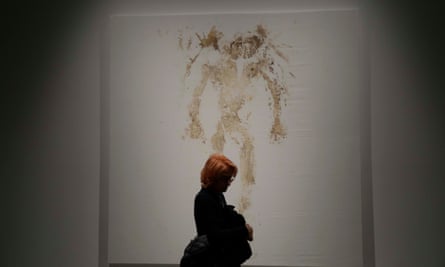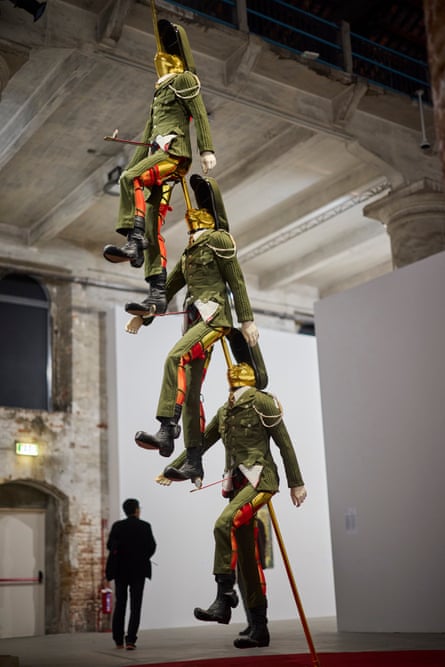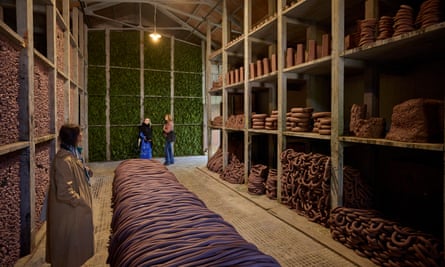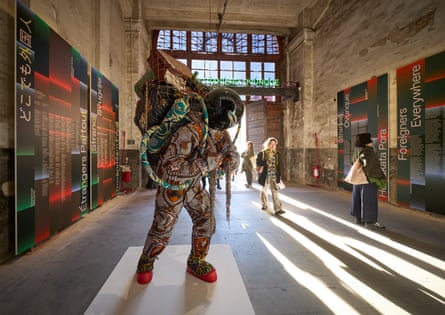Venice. Terrible. Foreigners everywhere, and it is even worse during the biennale, where the exhibition opened to the public on Saturday. Marked by unrest and protests, the 60th Venice Biennale leaves us uncertain of art’s ability to draw us together in a world in crisis. It is filled with the clamour of conflicting voices and doubtful purpose.
On posters and on the sides of the water buses, written in neon and hung in the entrances to the central pavilion in the Giardini and to the Arsenale, the phrase Foreigners Everywhere, written in languages living, endangered and dead, is ubiquitous. Dangling in a roofed-over section of the medieval dock, the words multiply, reflecting brightly in the sullen waters below with a cheer that belies a general unease. Often muttered in under-the-breath complaint, Foreigners Everywhere also celebrates difference, and the multiplicity of voices that fill the city. It also provides the title to curator and artistic director Adriano Pedrosa’s keynote exhibition.
In all its multilingual iterations, the phrase is also an ongoing work by Palermo-based “readymade artist” Claire Fontaine (whose name is a borrowing from the well-known French stationery brand). Claire Fontaine (who are actually a duo) have queered the phrase, lending its pungency and ambiguity to a biennale that I wish were nearly so succinct. There are longueurs. There are detours and incomprehensible delays. Interrupted by strange encounters and chance meetings, occasionally we are astonished and beguiled, led astray, tantalised and sometimes shocked.
Every one of us is a foreigner somewhere, often even when we are at home.
In flights of birds, teeming shoals of fish and travelling people, a story of origins and migrations unfolds in dizzying colours and patterns, across the facade of the central pavilion, in a gorgeous mural painted by MAHKU, a group of indigenous Huni Kuin artists from Acre in Brazil, near the border with Peru. The mural describes an ancestral journey across the Bering Strait, from Asia to the Americas, on the back of an alligator. Myths and rites of passage, group migrations and individual crossings, arrivals and departures, wars at home and deaths at the border mark both the biennale and Pedrosa’s exhibition. Inside the pavilion, an anonymous corpse has left his smeary, bloody trace on the sheet which once covered his body. Teresa Margolles’ Tela Venezuelana bears the miserable imprint of a Venezuelan migrant’s body, killed as he crossed into Colombia in 2019.

Nearby, pictures of immigrants overlain with the phrase Exile Is a Hard Job feature in the work of Paris-based Nil Yalter, one of the winners of a Golden Lion for lifetime achievement. Then we move on into a world of mid-20th-century painted abstractions and sculptures, the first of several sections in Pedrosa’s show that look at the way artistic languages attempt a lingua franca and a universality that they can never really have. Charting the journey of European modernism to the global south, and the ways in which it was adopted and adapted, and with belated takes on cubism, derivations from Giacometti, geometric abstraction and post-war informalism, kitschy scenes and unadventurous but sometimes flashy self-portraiture, these works add very little. There’s not much to make one pause.
Then you come across something that stops you in your tracks: Colombian artist Aycoobo (AKA Wilson Rodríguez) and his father Abel Rodríguez, who trained as a botanical expert among several Amazonian ethnic groups, both depict trees and wildlife, and the interconnectedness of the natural and the spiritual worlds, with a liveliness and sense of wonder that also, inevitably, make us aware of how much is being irretrievably lost to us, the world being diminished by the second.
Retreating into her inner visions after the death of a child, outsider artist Madge Gill made thousands of drawings of bristling forms, repeated, blank-eyed young women and proliferating pattern, without travelling much further than her room in London. Her journeys into unseen worlds were entirely in her head. Later in Pedrosa’s show, over at the Arsenale, we meet Susanne Wenger, who fled her native Austria to escape Nazism and ended up on a spiritual journey that led her to Nigeria where she became consecrated as a Yoruba priestess and living deity.
Xiyadie, a gay Chinese man whose compulsive, decorative papercut images feature unrestrained, intimate sex scenes and eroticised self-mutilation, is on a no less urgent quest for a voice. Navigating Pedrosa’s thematic landscape is difficult. Sometimes his show is just all over the place. One minute we are looking at the United States’ treatment of Puerto Ricans, training young women for work as housemaids in well-heeled American suburbs, the next at some painstaking appropriations of the work of Agnes Martin.

Yinka Shonibare’s helmeted astronaut, in a wax-batiked spacesuit and carrying a sack of meagre possessions on his back, is stilled mid-stride, as he walks into the Arsenale. He’s a stranger in a strange land, walking towards the zebra-striped shade cast by a huge overhead lattice, threaded from taut industrial cargo straps, in emulation of woven Māori birthing mats, and made by the Mataaho Collective, a group of four Māori women from Aotearoa. Next we find ourselves in a panoramic embroidery of daily life in a Chilean fishing village.
Maybe we shouldn’t expect too much coherence. It is all about the journey through an exhibition that is frequently transcultural, transdisciplinary, transtemporal, transsexual and even at times post-human.
In Mexican Bárbara Sánchez-Kane’s 2021 Prêt à Patria, live, menacing soldiers, whose uniforms open up to reveal lacy underwear, goose-step around a flagpole on which more soldiers (thankfully made of resin) are impaled like kebabs, the pole skewering them from arse to mouth, as they climb towards the roof of the Arsenale.
Ahmed Umar, cross-dressed and performing a Sudanese bridal dance in a small video installation, spent his childhood in Mecca, his femininity marking him out and excluding him when he reached puberty. According to the catalogue, Umar, who eventually emigrated to Norway, “increased his intake of Norwegian chocolates to enlarge his physical silhouette” and accentuate his curves. His dance is full of life and joy and resistance.
La Chola Poblete mixes queer imagery, pop references, the Virgin Mary and the goddess Pachamama, fantasy, swooping condors and heterogeneous folkloric scenes in her large, diaristic drawings, which offer yet another form of resistance to social norms in the macho culture of Argentina.
In eight large video projections, hands trace circuitous journeys across maps of Europe and North Africa. Moroccan artist Bouchra Khalili met migrants from Africa, the Middle East and South Asia at train stations and got them to describe their desperate journeys across the Mediterranean to Europe. Going this way and that, being stalled and moving on, doubling back and going at tangents, they search for safety, however temporary, and a means of survival.
after newsletter promotion

The journey of modernist, western art to the global south and the migration of Italian artists across continents are all part of the complex mappings and stories Pedrosa’s exhibition tells. In the historical section Italians Everywhere, orientalists, fortune seekers, escapees from fascism, antisemitism and poverty in Italy found themselves in foreign places. Some ended up in Brazil and Argentina, and their works are displayed on freestanding glass easels designed by Italian-born Brazilian architect and designer Lina Bo Bardi. Air-lifted in from the museum they were designed for in São Paolo and reinstalled in the Arsenale, the works themselves often don’t bear the scrutiny.
Another São Paolo-based Italian artist, Anna Maria Maiolino, who has also won a Golden Lion, closes Pedrosa’s exhibition in a small building, the Casetta Scaffali, in a garden at the far end of the Arsenale. Maiolino, born in 1942, has filled the building with racks for dozens upon dozens of unfired clay balls, writhing, spaghetti-like mounds and coils, and heavy, fecal sausages of pugged clay. There are small, indented marble-sized balls, misshapen globs, blocks cut like cheese and lumpy aggregations, some bearing the artist’s touch and modelling. This is material as potential. As well as the clay itself, a wall of pine fronds lightens the earthy tang. Sounds pierce the air in the cloistered space, and the overall effect is magical. Like many of the artists here (it almost seems to be a rule in Foreigners Everywhere) this is the first time the 81-year-old artist has exhibited at the biennale, her presence long overdue. So too is the inclusion of so many indigenous artists from the global south.
But instead of the global south, a deferred elsewhere, we should probably talk more plainly about the global majority, whose pressing needs and voices cannot be kept on hold. A rain of bullets, arrested in mid-flight, is suspended from filaments in the Brazil pavilion in the Giardini, confronting a similarly suspended clutch of painted gourd rattles, belonging to the indigenous Tupinambá community. Time has stopped. Brazil has been renamed the Hãhãwpuá pavilion, and this stalled moment feels vertiginous and awful. Intimations of violence are everywhere in the Giardini, among the national pavilions. In the Polish pavilion, video recordings of Ukrainians, mimicking the sounds of Russian weaponry, ask us to perform our own repeat-after-me karaoke response. Made all the more harrowing by being turned into something like a children’s game (kids love to imitate the noise of machine guns and explosions) the Ukrainian Open Group’s collective work left me speechless and winded.
People are dropping dead, theatrically, in a wrecked, abject series of rooms, on three storeys, where dust fills the air, the toilets are clogged and everything is mired in filth in the German pavilion. Theatre and opera director Ersan Mondtag’s work is based on the life of his Turkish grandfather, who died from asbestos poisoning as a result of working as a poor immigrant in Germany. Mondtag’s installation can’t help but remind me of Gregor Schneider’s 2001 installation in the same space, but misery is never done. Mondtag’s work rises from the middle of the pavilion, and is surrounded, in stark contrast, by Yael Bartana’s sci-fi installation, which posits the idea of an escape to outer space. I am disquieted by the juxtaposition, and the handwringing theatricality of both Bartana and Mondtag’s works struck the wrong note in 2024, where flashmob protests in the Giardini and calls for an end to the destruction of Gaza overshadowed much more than just the biennale.

For Egypt, Wael Shawky has produced the long video performance Drama 1882, about the 19th-century Urabi revolution, filmed in a theatre in Alexandria. Focusing on the political shenanigans and manoeuvring behind the British bombardment of the city, Shawky’s eight-part narrative is a reminder of Britain’s historical, imperial role in so many ongoing disasters.
Bleak and tender photographs by Inuutteq Storch document daily life and remnants of shamanic ritual among the Kalaallit population in Greenland, underscored by the influence of Danish colonialism. Storch’s work in the Danish pavilion is understated and elegiac, and shows how smaller, more modest proposals can make the most sense, and are all the more telling, in the current biennale.
Outside the Giardini in the Croatia pavilion, London-based artist Vlatka Horvat’s By the Means at Hand invites numerous artists, none of whom are living in their native countries, to send small artworks by hand, via friends and strangers, to be shown in the pavilion. Horvat responds in an ongoing, reciprocal series of photocollages. The project is all about trust, solidarity, improvisation and generosity, and will evolve over the coming months. The show is an ongoing open conversation, a model of exchange and dialogue we could all do with more of, and one entirely without posturing or grand statements.
Something of this sense of communality continues in Nigeria Imaginary, a fascinating small offsite pavilion that looks into the country’s troubled past and retrieves the idea of identity from ethnographic certainties. There’s a real sense here of creative ingenuity, material complexity and dialogue.
But how easily, and quickly, things turn sour. Outside the biennale, Christoph Büchel has performed a wretched takeover of the Prada Foundation, reducing the entire palazzo into a closed-down Pawnshop. Squalid toilets sit in corners. Rooms are filled with abandoned casino gaming tables. Stalls selling guns and bombs, diamonds, paintings, and all the detritus of modern life are piled high. All the traders and moneymen and dodgy entrepreneurs, the diamond sellers, the art dealers, the soiled clothing racketeers and the bitcoin moguls have lit up and gone, leaving only the wandering art lovers to the filthy, artfully distressed rooms, wondering what they are looking at and why. Beyond a door to the palazzo’s private dock, the cognoscenti are queueing for water-taxis, to the next pavilion or the airport, to ferry them to De Kooning at the Academia or to the next collateral biennale event. Sometimes collateral just means damage.
The Venice Biennale ends 24 November
